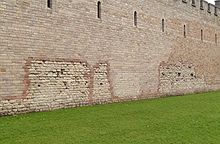Cardiff Roman Fort
| Cardiff Roman Fort | |
|---|---|
 Reconstructed Roman gateway to Cardiff castle | |
| Place in the Roman world | |
| Province | Britannia |
| Location | |
| Coordinates | 51°28′56″N 3°10′53″W / 51.4822°N 3.1814°W |
| Town | Cardiff |
| Country | Wales |
| Reference | |
| UK-OSNG reference | ST180765 |
Cardiff Roman Fort was a coastal
Name

The fort's name is uncertain. It could have been Tamium as appears in the Ravenna Cosmography, although this may have been a river name and thus refers to the River Taff. Alternatively it may be Bovium (corrected from Bomio) of the Antonine Itinerary.
Early forts
Prior to the building of the extant fort, there were at least two previous
Carausian shore fort

Around 290, a 9-acre (3.57 hectare) shore fort was built on the site, not unlike the almost complete example at Portchester in Hampshire. Its walls were ten feet thick and it was positioned to control access to the upper reaches of the River Severn. There may have been associated watch towers on the now eroded cliffs to the west. This is believed to have been the Emperor Carausius' response to increased Irish raids. Its military/naval force eventually moved elsewhere about 370.
Post-Roman legends
The ruinous fort appears as the residence of 'King Ynwyl' in the story of
References
- Notes
- ^ Goodall 2008, p. 3
- Bibliography
- Arnold, Christopher J.; Davies, Jeffrey L (2000). Roman & Early Medieval Wales. Stroud: Sutton Publishing.
- ISBN 978-1-84802-007-8
- Rivet, A. L. F.; Smith, Colin (1979). The Place-Names of Roman Britain. London: B. T. Batsford.

